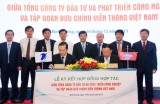Binh Duong on way of developing into first-class city
In the period of 2016 and 2020, Binh Duong’s Party, government and people will try to develop the locality into a centrally-controlled municipality. The province has also made careful preparations for the target.
Towards the image of a modern city
According to provincial Department of Construction, Binh Duong now has TDM as the second-class urban area; Thuan An, Di An, Ben Cat and Tan Uyen as the fourth-class urban areas; Phu Giao, Dau Tieng, Bau Bang and North Tan Uyen as the fifth-class urban areas. The rate of the province’s urbanization has reached 78.9%; urban areas herein have step by step flourished with modern and synchronous socio-technical infrastructure.
.jpg)
Binh Duong strives to become a centrally-controlled municipality in the period of 2016 and 2020. In picture: A glance of TDM city
According to architect Tran Ngoc Chinh, Chairman of the Vietnam Urban Planning and Development Association, there are 6 criteria for urban evaluation. They include urban functions, population scale, population density, non-agriculture labor force rate, urban infrastructure facilities, and urban architecture and landscapes. A centrally-controlled municipality must have functions as a hub of economics, culture, science-technology, administration, education-training, tourism-services with regional and international traffic connection. Binh Duong must have a role promoting socio-economic development of an inter-provincial region or the entire country.
Binh Duong is expressing its important role in the Southern key economic zone. The whole province is now home to 28 industrial parks (IPs) with 9,431 hectares in total, mostly in Di An, Thuan An and Tan Uyen towns. It is expected that there will be additional 11 IPs with 8,793 hectares in total between 2016 and 2020, bringing the total numbers of IPs in the province to 39 with more than 18.220 hectares in total.
Other advantage is that Binh Duong’s traffic infrastructure has received methodical investment with regional and international connection ensured. For example, the HCM city-TDM-Dong Xoai route is connected with the belt roads 2,3 and 4. There is also a railroad from HCM city to Cambodia through Binh Duong and Hoa Lu border gate in Binh Phuoc, linking to ASEAN countries. Besides, province-based IPs are connected with the Cai Mep-Thi Vai sea port, Long Thanh international airport via the Tan Van-My Phuoc expressway.
Such these apart, Binh Duong is one of the country’s localities with great investment attraction. There has been an increase in both quantity and quality with strong investment from global-sized corporations, namely Tokyu Procter & Gamble, Uni-President …
Target to be fulfilled soon
Binh Duong has so far reached some important criteria to become a centrally-controlled municipality by 2020.
Regarding urban functions, according to experts, Binh Duong has positively affected the sustainable development of the Southern key economic zone. The province has also taken the lead in the development process with strong and quick growth speed and economic structure shift.
The province’s GDP (gross domestic product) per capita is likely to achieve US$6,170 a year by 2020. The figure will amount to US$12,000 by 2025. In terms of population, Binh Duong now has nearly 2 million people and the figure is expected to reach 2.5 million people by 2020.
The province has also basically completed all urban works in the inner-city areas. 100% of production facilities have been built under the plan at province-based concentrated IPs.
In addition, the rate of non-agricultural laborers in the inner-city areas of the province has reached 90%. The province is also capable of obtaining a population density at 12,000 people per square kilometer, according to experts.
To Mr. Chinh, criterion on urban architecture and landscapes is also very vital for Binh Duong’s roadmap of developing into a first-class city. Accordingly, the province’s urban development and construction under the new regulation on urban architecture management must meet standards of a model city and more than 50% of main urban streets must be recognized as civilized ones. The province also needs to ensure a public space to serve locals’ spiritual life together with outstanding architectural works bearing national significance.
Reported by Phung Hieu-Translated by K.T
- Agro-forestry-aquatic product exports rise by 19% in six months (05/07)
- Bau Bang: Many economic targets gain high growth compared to same period (05/07)
- Orders gradually increase, businesses strengthen production (05/07)
- Banks intensify customer assistance setting up biological authentication (04/07)
- EuroCham confident in Vietnam's stable economic development (04/07)
- Vietnam’s int'l aviation market rebound (04/07)
- Removing difficulties in loan for social housing buyers (04/07)
- Creating the best conditions for Becamex IDC to develop (03/07)
 Orders gradually increase, businesses strengthen production
Orders gradually increase, businesses strengthen production
 Participation in fairs and exhibitions: More opportunities to promote Vietnamese products
Participation in fairs and exhibitions: More opportunities to promote Vietnamese products
 Novel impetus for investment attraction created
Novel impetus for investment attraction created
 Creating the best conditions for Becamex IDC to develop
Creating the best conditions for Becamex IDC to develop
 Province urgently clears sites for key projects
Province urgently clears sites for key projects
 To promote innovation and development of sciences and technologies
To promote innovation and development of sciences and technologies
 Protecting, enhancing the brand value of Binh Duong wood industry
Protecting, enhancing the brand value of Binh Duong wood industry
Regional connectivity levers economic growth
Garment, textile industry urged to make change to adapt to new challenges
 PM’s trip expected to open up trade cooperation opportunities for Vietnam, RoK
PM’s trip expected to open up trade cooperation opportunities for Vietnam, RoK







